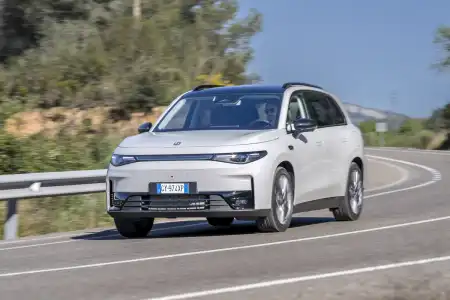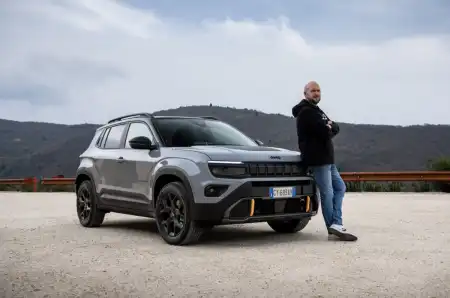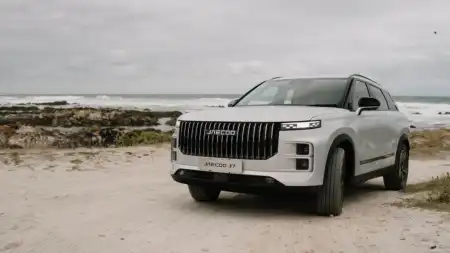- Comfortable and easy to drive
- Practical with plenty of passenger and luggage space
- Decent efficiency and great motorway cruiser
- Occasional lag under heavier acceleration
- Some rivals offer a more upmarket interior
- Would like paddles for manual gear changes
Introduction
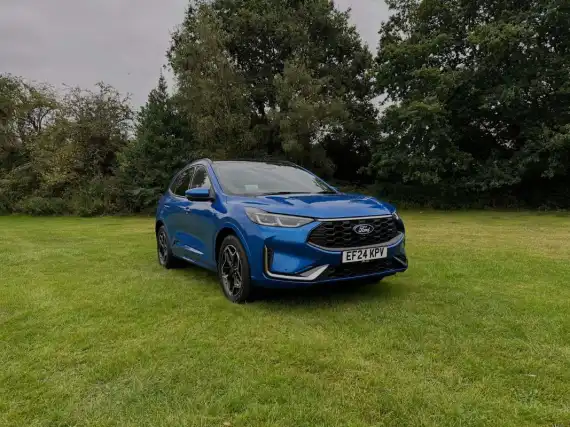
The third generation Kuga was launched back in 2019, so it was very much due a refresh, especially with so many rivals out there upping their game. And that’s exactly what Ford has done with the 2024 Kuga gaining a fresh front end, lots of updated tech, plenty of powertrain choice and a great selection of trim levels.
There are 1.5-litre EcoBoost petrol engines and 2.5-litre Duratec powertrains with self-charging or plug-in hybrid technology, along with manual or CVT transmissions, plus two- or four-wheel drive.
In addition, generously-equipped trim levels called Titanium, Active, ST-Line and ST-Line X give customers plenty of scope to get the exact model they want.
We opted for the Ford Kuga ST-Line X powered by the 2.5-litre Duratec self-charging hybrid engine and all-wheel drive for our test.

The 2024 Kuga has a new look, especially when approached from the front, which Ford claims makes the five-door SUV look extra assertive. A full-width LED light bar frames the new front grille which proudly displays the Ford oval badge. And this light bar connects the LED Matrix headlights.
There is a large rear spoiler, panoramic sunroof, privacy glass, LED rear lamps, ST Line body styling, black roof rails, along with 19-inch ST-Line alloy wheels with red brake calipers.
Moving inside, the cabin is clutter-free with the main focal point being a 13-inch touchscreen with Ford’s latest SYNC 4 infotainment set-up which offers twice the computing power of its predecessor. Features include wireless Apple CarPlay and Android Auto, along with sat nav, a 10-speaker sound system with DAB radio, a 360-degree camera and plenty more besides.
Everything is very simple to operate on the fly with the bottom part of the screen offering quick access to climate control settings, including the heated seats and steering wheel. Then all the main driving data is clearly viewed on a 12.3-inch digital cluster that can be personalised to taste with the added convenience of a head-up display too.
The front seats are power adjustable and have memory settings to store favourite positions. This is really handy if the car is shared between drivers. Back seat passengers also benefit from heated seats and there are USB-C ports front and rear.
My only slight gripe was the over-use of hard plastic throughout which rather lowers the standard in an otherwise upmarket cabin.
On The Road
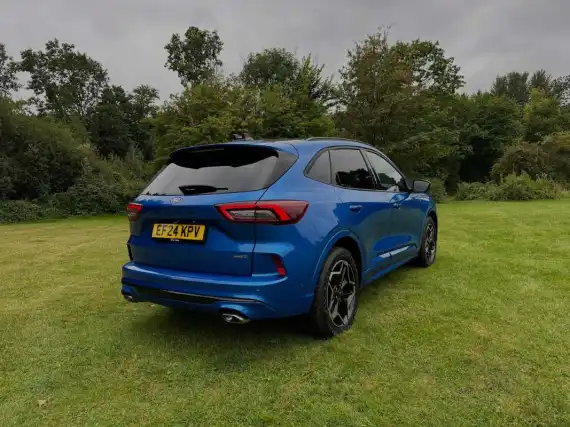
Handling & Performance
Our Ford Kuga was powered by a 2.5-litre FHEV powertrain, which stands for Full Hybrid Electric Vehicle. This is a self-charging model so there is no need to plug the car in to boost the battery.
With 183PS on tap, it can sprint to 62mph from a standing start in a very respectable 8.3 seconds and has a top speed of 122mph.
While the plug-in model will offer the best financial rewards for business drivers thanks to its low carbon emissions figure, the FHEV is a good choice for private buyers. In city driving, with lots of stop, start driving, the car will run in pure electric mode with battery levels boosted via regenerative braking. And then the petrol engine will join in when extra power is needed for sharper bursts of acceleration. This all goes on automatically in the background without any input from the driver.
But there are drive modes that will change the dynamics and efficiency of the vehicle and these are called Normal, Eco, Sport and Slippery.
Sport is the ideal mode for tackling twisting country lanes when extra dynamic handling might be called for, while Normal is the best setting for motorway cruising – something the Kuga does very well by the way.
The acceleration through the automatic gearbox is smooth and responsive, although I would have liked some paddles to take manual control of the gear switching at times.
The sport suspension set-up is a little on the firm side, but will smooth out all but the most severe road bumps and the cabin is beautifully refined with barely a sound filtering through.
The Kuga is perfect for weekend breaks to the countryside as it boasts a braked towing capacity of 2.1 tonnes. And with all-wheel drive, there is little chance of getting bogged down.

Space & Practicality
The Ford Kuga needs to cover all the practicality bases well and it does just that with a spacious cabin and plenty of luggage room too.
It stretches 4,615mm in length, is 2,177mm across (including mirrors), 1,651mm in height and has a wheelbase of 2,711mm.
The driver and front seat passenger are treated to plenty of space and back seat occupants also benefit from decent leg room, provided the front seats are not pushed too far back. In addition, thanks to its height, there is a good amount of head clearance, even for six footers. The middle seat is slightly raised and anyone bundled into the least popular place in any car, will also have to straddle a central hump. But it is fine for shorter journeys.
The wide opening doors make it easy to access a child seat with Isofix anchors to the outer rear seats, In addition, the slightly elevated seating will be beneficial to anyone with mobility issues. The rear seats also slide back and forth to create extra boot space when needed.
This means with five seats upright, the boot can swallow between 395 and 553 litres (depending on the position of the back seats). This capacity increases to 1,534 litres with the 60:40 split-folding seats dropped flat.
Elsewhere there are numerous storage options throughout the Kuga, including a glovebox, central cubby with a tray, door bins, a sunglasses compartment, seat back pockets, front and rear cup holders, a wireless charging pad and some trays.
Ownership

Running Costs
The Ford Kuga line-up is competitively priced with the entry-level Titanium model with the 150PS 1.5-litre engine costing £32,095 and, at the other end of the scale, the Kuga ST-Line X powered by a 2.5-litre 243PS plug-in hybrid unit rolling in at £42,455.
Our test car, the Kuga ST-Line X with the 183PS 2.5-litre self-charging powertrain, was the second most expensive version costing £42,365, although Desert Island Blue premium paint added £800 to the cost, a tow bar £850 and a Technology Pack bumped up the price by a further £900. This pack introduced glare-free dynamic Matrix LED headlights, a front light bar and a head-up display.
According to WLTP-tested figures, the test car could deliver a combined 47.1mpg with carbon emissions of 137g/km. This CO2 output would result in a first year road tax bill of £260, dropping to the standard fee for hybrids of 180 after 12months.
However, as the cost of the Kuga we tested was above the £40k threshold, there is an additional government levy to factor in. From years two to six, owners will need to find an extra £410 as the vehicle is subject to a premium car tax.
Verdict
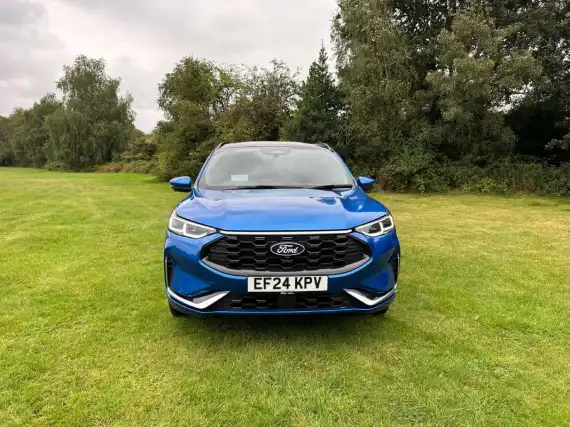
Upgrades between new generations can always be tricky for manufacturers. They need to introduce new features and tweak design aspects without totally revamping the vehicle. Ford has done a great job with this revised third-gen car which looks more in line with other Ford models, while also introducing the latest technology, plus additional safety features to the mix.
It's not the most dynamic SUV to drive, but it does cover most bases very well and not all owners will want to be blasting their way down twisting country lanes. They will probably be more concerned with the practical and economical factors, aspects in which the Kuga excels.

